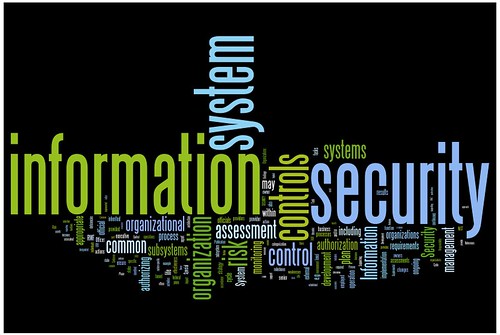“Machines Don’t Cause Risk, People Do!”
Posted May 26th, 2010 by Vlad the ImpalerA few weeks back I read an article on an apparent shift in emphasis in government security… “OMB outlines shift on FISMA” take a moment to give it a read. I’ll wait….
That was followed by NASA’s “bold move” to change the way they manage risk…
Once again the over-emphasis and outright demagoguery on “compliance,” “FISMA reports,” “paper exercises,” and similar concepts that occupy our security geek thoughts have not given way to enlightenment. (At least “compliancy” wasn’t mentioned…) I was saddened by a return to the “FISMA BAD” school of thought so often espoused by the luminaries at SANS. Now NASA has leapt from the heights… At the risk of bashing Alan Paller yet again, I am often turned off by the approach of “being able to know the status of every machine at every minute, ” – as if machines by themselves cause bad security… It’s way too tactical (incorrect IMHO) and too easy to make that claim.
Hence the title of this rant – Machines don’t cause risk, people do!
The “people” I’m talking about are everyone from your agency director, down to the lowliest sysadmin… The problem? They may not be properly educated or lack the necessary skills for their position – another (excellent) point brought forth in the first article. Most importantly, even the most seasoned security veteran operating without a strategic vision within a comprehensive security program (trained people, budget, organizational will, technology and procedures) based upon the FISMA framework will be doomed to failure. Likewise, having all the “toys” in the world means nothing without a skilled labor force to operate them and analyze their output. (“He who dies with the most toys is still dead.”) Organizations and agency heads that do not develop and support a comprehensive security program that incorporates the NIST Risk Management Framework as well as the other facets listed above will FAIL. This is nothing new or revolutionary, except I don’t think we’ve really *done* FISMA yet. As I and others have said many times, it’s not about the paper, or the cost per page – it’s about the repeatable processes — and knowledgeable people — behind what the paper describes.
I also note the somewhat disingenuous mention of the risk management program at the State Department in the second article… As if that were all State was doing! What needs to be noted here is that State has approached security in the proper way, IMHO — from a Strategic, or Enterprise level. They have not thrown out the figurative baby with the bath water by dumping everything else in their security program in favor of the risk scoring system or some other bright, shiny object. I know first-hand from having worked with many elements in the diplomatic security hierarchy at State – these folks get it. They didn’t get to the current level of goodness in the program by decrying (dare I say whining about?) “paper.” They made the organizational commitment to providing contract vehicles for system owners to use to develop their security plans and document risk in Plans of Action and Milestones (POA&Ms). Then they provided the money to get it done. Is the State program a total “paragon of virtue?” Probably not, but the bottom line is that it’s an effective program.

Mammoth Strategy, Same as Last Year image by HikingArtist.com.
Desiring to know everything about everything may seem to some to be a worthy goal, but may be beyond many organization’s budgets. *Everything* is a point in time snapshot, no matter how many snapshots you take or how frequently you take them. Continuous, repeatable security processes followed by knowledgeable, responsible practitioners are what government needs. But you cannot develop these processes without starting from a larger, enterprise view. Successful organizations follow this–dare I say it–axiom whether discussing security governance, or system administration.
Government agencies need to concentrate on developing agency-wide security strategies that encompass, but do not concentrate on solely, what patch is on what machine, and what firewall has which policy. Likewise, system POA&Ms need to concentrate on higher-level strategic issues that affect agencies — things like changes to identity management schemes that will make working from home more practical and less risky for a larger percentage of the workforce. Or perhaps a dashboard system that provides the status of system authorization for the agency at-a-glance. “Burying your head in a foxhole” —becoming too tactical — is akin to burying it in the sand, or like getting lost in a bunch of trees that look like a forest. When organizations behave this way, everything becomes a threat, therefore they spray their resource firepower on the “threat of the day, or hour.”
An organization shouldn’t worry about patching servers if its perimeter security is non-existent. Developing the larger picture, while letting some bullets strike you, may allow you recognize threats, prioritize them, potentially allowing you to expend minimal resources to solve the largest problem. This approach is the one my organization is following today. It’s a crawl first, then walk, then run approach. It’s enabled management to identify, segregate, and protect critical information and resources while giving decision-makers solid information to make informed, risk-based decisions. We’ll get to the patches, but not until we’ve learned to crawl. Strangely, we don’t spend a lot of time or other organizational resources on “paper drills” — we’re actively performing security tasks, strategic and tactical that follow documented procedures, plans and workflows! Oh yes, there is the issue of scale. Sorry, I think over 250 sites in every country around the world, with over 62 different government customers tops most enterprises, government or otherwise, but then this isn’t about me or my organization’s accomplishments.
In my view, professional security education means providing at least two formal paths for security professionals – the one that SANS instantiates is excellent for administrators – i.e., folks operating on the tactical level. I believe we have these types of security practitioners in numbers. We currently lack sufficient seasoned professionals – inside government – who can approach security strategically, engaging agency management with plans that act both “globally” and “locally.” Folks like these exist in government but they are few. Many live in industry or the contractor space. Not even our intelligence community has a career path for security professionals! Government as a whole lacks a means to build competence in the security discipline. Somehow government agencies need to identify security up-and-comers within government and nurture them. What I’m calling for here is a government-sponsored internal mentorship program – having recognized winners in the security game mentor peers and subordinates.
Until we security practitioners can separate the hype from the facts, and can articulate these facts in terms management can understand and support, we will never get beyond the charlatans, headline grabbers and other “self-licking ice cream cones.” Some might even look upon this new, “bold initiative” by NASA as quitting at a game that’s seen by them as “too hard.” I doubt seriously that they tried to approach the problem using a non-academic, non-research approach. It needed to be said. Perhaps if the organization taking the “bold steps” were one that had succeeded at implementing the NIST guidance, there might be more followers, in greater numbers.
Perhaps it’s too hard because folks are merely staring at their organization’s navel and not looking at the larger picture?
Lastly, security needs to be approached strategically as well as tactically. As Sun Tzu said, “Tactics without strategy is the noise before defeat.”
Similar Posts:
Posted in FISMA, NIST, Public Policy, Rants, Risk Management, What Doesn't Work, What Works |  14 Comments »
14 Comments »
Tags: 800-37 • 800-53 • 800-53A • accreditation • auditor • C&A • cag • cashcows • catalogofcontrols • categorization • certification • comments • compliance • fisma • FUD • gao • government • infosec • infosharing • itsatrap • management • metrics • moneymoneymoney • NIST • omb • publicpolicy • pwnage • risk • scalability • security
 Posts RSS
Posts RSS



